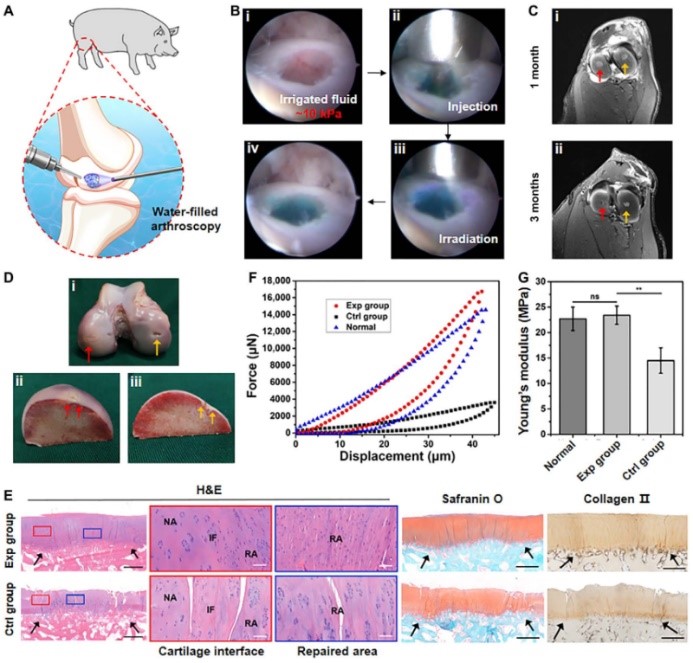A hydrogel scaffold for direct tissue-engineering can have a number of applications clinically, including for example, water-irrigated, arthroscopic cartilage repair. A versatile hybrid photocrosslinkable (HPC) hydrogel has been fabricated though a combination of photoinitiated radical polymerization and photoinduced imine cross-linking. The ultrafast gelation, high mechanical strength, and strong adhesion to native tissue enable the direct use of these hydrogels in irrigated arthroscopic treatments, which has been shown to serve as an arthroscopic autologous chondrocyte implantation scaffold for long-term cartilage regeneration, integration, and reconstruction of articular function. For the treatment of oral mucosal diseases, a photo-crosslinking hydrogel adhesive inspired by the success of light-curing techniques in dentistry is developed, which operates on a fast (within 5s) phototriggered S-nitrosylation coupling reaction and employs imine anchoring to connect to host tissues. This new gel adhesive creates a favorable microenvironment for tissue repair and can shorten tissue healing time. For developing effective strategies for vascular tissue engineering, disease modeling and therapies, how matrix stiffness regulates SMC phenotype and matrix remodeling through TGF-β signal pathway has been studied, unraveling the underlying mechanobiological mechanism in vascular remodeling.

Ultrafast, tough, and adhesive hydrogel for articular cartilage repair
Selected Publications:
1. Zhang W, Bao B, Jiang F, et al. Promoting oral mucosal wound healing with a hydrogel adhesive based on a phototriggered S‐nitrosylation coupling reaction. Advanced Materials, 2021, 2105667.
2. Hua Y, Xia H, Jia L, et al. Ultrafast, tough, and adhesive hydrogel based on hybrid photocrosslinking for articular cartilage repair in water-filled arthroscopy. Science Advances, 2021, 7: eabg0628.
3. Tian B, Ding X, Song Y, et al. Matrix stiffness regulates SMC functions via TGF-β signaling pathway. Biomaterials, 2019, 221: 119407.
4. Wang G, Yang H, Wu W, Zhang P, and Wang J. Design and optimization of a biodegradable porous zein conduit using microtubes as a guide for rat sciatic nerve defect repair. Biomaterials, 2017, 131:145-159.
5. Chen W, Tian B, Liang J, Yu S, Zhou Y, and Li S. Matrix stiffness regulates the interactions between endothelial cells and monocytes. Biomaterials, 2019, 221: 119362.